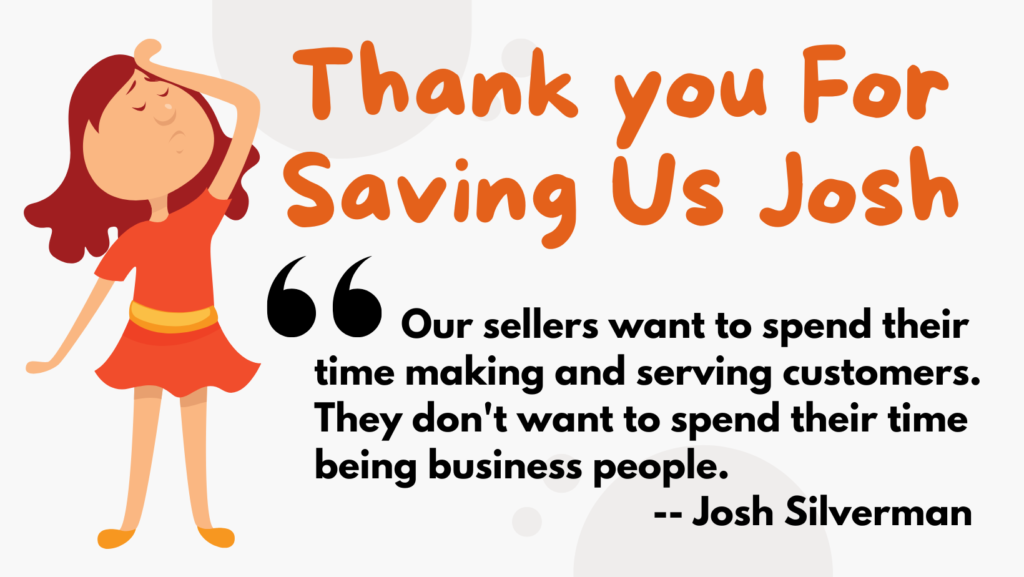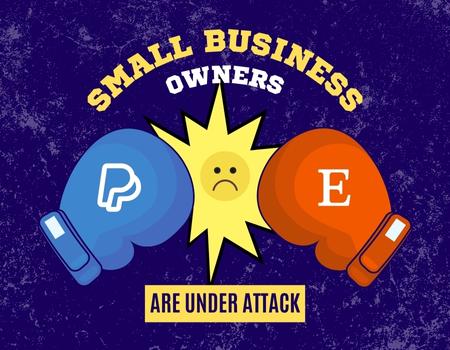Ya Got Trouble, Lots & Lots of Trouble – Trouble with a Capital E
I was going to start this post by saying that Etsy used to be a great place to sell at. But thinking back to when I started 6 years ago, it’s actually been a fairly rough ride. There are 3 factors that made the ride rough in those earlier years.
1. A lack of quality customer service and
2. Serious glitches in their software / site functionality and
3. Constant experimentation with new features (with often disastrous results for sellers) and really big changes to the algorithm especially at the start of the holiday season.
Which means that every time they implement something new, they would have a major glitch that could hugely impact your sales, and then you would not be able to get hold of someone to fix it in a timely manner. Were sales good? Yes. They were great. But a lot of time and money was wasted chasing the algorithm changes and trying to solve problems.
Unfortunately, none of those 3 issues were resolved before the pandemic hit. So with the sudden influx of new buyers followed by a now non-stop wave of scammers (both sellers and buyers), Etsy’s growing pains have become larger than life.
Biggest Problem Number 1 – Keep Commerce Inhuman
Despite their promise to Keep Commerce Human, Etsy seems determined to make it as inhuman as possible. Etsy appears to have significantly increased its use of bots to manage almost all aspects of both buyer and seller transactions and management and oversight of all seller stores. I should add that the bots appear to be making decisions without any human involvement at all. And decisions are often made with zero or minimal communication to the seller. No specific explanations, no instructions, no timelines.
I don’t want to sound overly-dramatic but the Etsy bots seem to be in charge now. And while they may be in place to help weed out potential and actual scammers and policy violators, there are many sellers that are not scammers or policy violators that are getting caught up in the always-too-wide bot nets. Instead of a more reasonable system where a well-programmed bot identifies a potential problem and then notifies staff to do a manual review, the bots seem to take immediate action on their own – closing cases, removing listings, forcing stores into vacation mode, putting stores on reserve, suspending stores – all before a seller has a chance to give any input or provide any evidence, or have any opportunity to appeal.
This creates an environment where your livelihood can be abruptly halted at any moment and for any reason and without any knowledge of what went wrong and how to fix it.

New Seller Suspensions
Instead of vetting new sellers before they come on board, Etsy will randomly suspend new shops within the first few months of opening. Etsy may or may not send you any notification when this happens. They will definitely not tell you why it was suspended or how and when it can be re-instated. Most of the time the store will be suddenly reinstated a few weeks later. But any sales momentum you had will be gone and you will need to start over.
Instant Case Closures
If a buyer has a problem with an order, Etsy encourages the buyer to contact the seller first and then open a case. When the buyer opens a case, and before the seller has a chance to respond to the case, Etsy has the right (according to their TOS) to automatically close the case (using bots) in the buyer’s favor and then refund the buyer from the seller’s funds. This automated process usually happens within a few minutes of the case being opened, and the seller has no opportunity to review the case, respond, or supply any proof that there is no problem or that the problem had already been resolved.
Most of the time, the case is opened because of a shipping issue, i.e., the buyer has not received the item yet. Buyers will get refunded even if the tracking shows that the item is still on it’s way. USPS also has a bad habit of marking items delivered a day or two before they are actually delivered, so there are many times when Etsy bots will automatically refund the buyer and then the buyer receives the order the next day. In either scenario, Etsy does not require buyers to return items so the seller is out both the item AND the money that Etsy refunded. Sellers have now seen an increase in the number of buyers opening cases as unscrupulous buyers discover that it’s an easy way to get a refund while still being able to keep the product. There are even TikTok and Instagram videos describing how buyers can do this to get free merchandise on Etsy.
Random Listing Takedowns
In an effort to better “police” Etsy stores to prevent fraud and scammers, Etsy has unleashed their not-very-well-trained AI system that regularly (and mistakenly) takes down listings that have no compliance issues or shuts down stores that also have no compliance issues. The most famous example happened when a lawsuit involving amber jewelry prompted Etsy to automatically remove amber jewelry but they ended up removing all listings that used the word “amber” to describe the color of a product and even a store that had the owner’s name (Amber) in a listing. To me, this seems like unbelievably poor programming and/or poor planning, especially for a company as big as Etsy.
Sales Nazi (No More Sales For You)
Etsy also use AI bots to decide if you have had a “surge” in sales and if that bot determines that you have too many sales it will automatically put your store in vacation mode until you ship all your orders. The bot programming does not seem to take into account the length of time a store has been operating without issues, so even a store that has NEVER had issues filling orders can suddenly find their shop on hold after a bump in sales.
Etsy cannot possibly have enough data about any seller and their shop to accurately assess how fast they can produce and ship products other than past history, and even then, I would expect that past history to show a recurring problem before Etsy should have any right to directly interfere with a shop’s ability to make sales.
You’re On Reserves, and You’re On Reserves, and You’re On Reserves!

Your store can be put on “Reserve” at any time and for any reason. Other marketplaces use a reserve system so it’s not uncommon to have this in place to protect the marketplaces from high-risk sellers. The problem is that Etsy has not defined what a “high-risk seller” is and they appear to be implementing reserves on stores that have been around for years and really should be categorized as low-risk. They’ve been holding up to 70% of seller’s funds in reserves for extended periods of time without always releasing them when items are shipped with tracking numbers (as promised). While your funds are on reserve, any Etsy fees are taken out of the little bit that Etsy releases, leaving you with very little cash flow to run your business.
The reserves have been so detrimental to seller’s businesses that, once again, sellers are up in arms. Two Facebook groups have been created to help organize a response to Etsy’s reserve actions. Sellers in the UK have been protesting about the reserves (see the Facebook Group: Etsy Reserve Strike) and there has been some press coverage about it recently https://www.bbc.com/news/business-66362229. Etsy has apparently made some adjustments to the amount of reserves that will be held (lowering some reserves from 70% to 30%) directly resulting from all the press coverage in the UK and after the UK government contacted them to discuss the reserves. Etsy actually enraged sellers even further when they sent out emails offering short-term loans to a lot of already very angry sellers on reserves!
A group has also formed for U.S. sellers called Indie Sellers Guild. The Indie Sellers Guild is attempting to bring the issues before the Federal Trade Commission and the U.S. Small Business Administration as unfair business practices. I also think that that California officials should be contacted as California has the largest number of active sellers in the U.S. at 14%. A well-known Etsy consultant, Starla Moore, has launched a #KeepEtsyHuman campaign and created a very well-done video that helps explain the issues around the reserves and other issues overall.
Biggest Problem #2 – Etsy Directly Interferes with A Seller’s Ability to Market & Sell Their Products
Etsy has shown over and over, through their actions and their speech, that they prefer to focus on buyers as their main customers, and that sellers can be easily replaced. Josh Silverman, in particular, seems to think of Etsy sellers as children that need to be helped. And, as another blogger points out – would he treat sellers the same way if they were predominantly men and not women? From an interview he did in 2018 “Our sellers want to spend their time making and serving customers. They don’t want to spend their time being business people.” See the post from While She Naps.

Micromanagement
Etsy’s main goal seems to be to control every aspect of a seller’s business that they can, to keep everyone in line and uniform, to meet extremely high standards that Etsy itself cannot even come close to. And they accomplish this with sticks not carrots. They don’t consult with sellers before developing “seller tools” that are allegedly to benefit sellers.
Their approach to new features appears to be: someone has an idea that will benefit BUYERS, it gets rolled out quickly to test with a few sellers and it’s marketed as a great new feature for SELLERS, sellers hate it and complain, Etsy launches it anyway with glitches, sellers flood Etsy with feedback saying they hate it, Etsy ignores them. Occasionally after seller protests start to gain momentum (maybe even petitions and “strike” threats), then Etsy will adjust a new feature slightly and present the changes as “we listened!”
Star Seller status is not that easy to get and maintain. It requires a minimum 95% on-time shipping (and Etsy does NOT automatically exclude holidays and Sundays from the length of time you set for your shipping profiles); it requires that you respond to 95% of your messages within 24 hours (whether it’s a message from a store you just purchased from or from someone pitching you their services and even on weekends); It requires that you have an average of 4.8 out of 5 stars for all reviews within the last year (and customers have the ability to review their orders before receiving their orders, plus there have been many reports of other sellers purposely purchasing items from their competition and tanking their store with bad reviews). Removing inappropriate or harassing or just plain weird reviews is either not an option or it’s very challenging to do. The most problematic part of these standards is the fact even Etsy itself cannot meet them.

Conform Or Else
Etsy wants you to ship items for free, ship everything using their labels, process orders rapidly and ship fast, and respond to customers within 24 hours even on the weekend. If you charge for shipping, Etsy will warn you if it thinks your shipping price is too high. Etsy wants you to put your items on sale regularly and at more than 10% off. Now they are working on new “pricing guidelines” to let sellers know what their prices should be. It’s being presented as a tool to help sellers figure out their pricing but, in reality, it’s just another way to force sellers to change the way they do business so that Etsy can attract discount shoppers. Which apparently they are intently focused on.
The irony is that the free and fast shipping and the steeper discounts & sales are going to be much easier for resellers to implement, a type of store that is against Etsy’s terms & conditions but very prevalent on Etsy right now. Etsy is creating an environment that encourage resellers and discourages actual handcrafters who are much less likely to be able to ship fast and offer steep discounts.
Do you have to follow all these rules? No. And yes. Etsy doesn’t say these actions are required but there is always the possibility that your listings will not show well in search if you do not follow them.

Crazy Experiments
Etsy has been experimenting and implementing weird new features that actually directly interfere with a seller’s ability to market and sell their items. The experimentation seems to have escalated recently, presumably in response to declining sales. Some of the features are so strange and counterintuitive that it feels like Etsy is grasping at straws in a desperate attempt to get customers at any cost.
They have moved the Description so far down the product detail page (below the item options, below shipping information, items highlights, and reviews) that customers are far less likely to read important information about the product, which can lead to more return requests, low reviews, and more cases opened.
Etsy has added tags to search for products in other stores WITHIN the seller’s product photo area. When a potential buyer clicks on a seller’s listing and checks the photos for that item, they will see a an extra photo that features linked tags similar to your own tags that when clicked will take the buyer away from your listing and back into search. To the buyer, it is actually not clear that they are leaving the listing they are looking at and being bumped back to search. Marketplaces always have a “other items you might be interested in” section near or below a seller’s listing but WITHIN the listing photo area is just going too far. SIDE NOTE: The linked tags/keywords that Etsy pulls in are quite often trademarked words that seller’s are using illegally to sell unlicensed products.
Etsy has launched a Make A Bid option for vintage sellers – which seems appropriate – and has now launched it for all sellers – which seems totally inappropriate. Sellers can opt into the program, which allows buyers to make a bid on an item in your store. The problem is that sellers are already reporting that they are getting messages from potential buyers asking if they can make bids when they have not opted into the program. It’s easy to see that this will cause unnecessary messaging burdens (not to mention a big time-waste) on sellers that have to respond to all messages within 24 hours in order to obtain or keep their Star Seller status. A bidding feature like this is yet another feature that is easier for resellers to utilize as they are more likely to have larger profit margins. The words “handcrafters” and “bidding” really should never be in the same sentence together.
Forced Offsite Ads
Sellers are forced to pay for off-site ads, whether they want to or not, as soon as you reach $10,000 in sales. Etsy used to pay for these ads but decided to shift part of that ad burden to the sellers starting in 2020. As with everything that Etsy does, this program suffers from convolution and zero transparency. Many sellers have reported suspicious issues with the off-site ads including declines in organic traffic for bestsellers with corresponding increases in offsite traffic for those listings (generating more fees for Etsy) and seller’s regular customers being targeted in Etsy ad campaigns on social media which brings them in to collect that extra percentage of sales for any purchases made within 30 days.
More Observations
Secret Buyer Demographics
Sellers are given no information about Etsy buyers to help determine if Etsy is still an appropriate venue for their type of shop. Etsy will give you all kinds of stats about Sellers but ZERO about buyers – no buyer demographics whatsoever. What have they got to hide? Maybe the fact that their buyer profile has changed significantly since the pandemic hit from mid & high-end buyers to discount shoppers. This is a very plausible scenario given the fact that Etsy has been pushing fast & free shipping, and larger sales & discounts.
When I first started on Etsy 6 years ago, the top stores were really cute high-end boutique baby shops and boutique wedding shops – all clearly handmade items that fit perfectly within Etsy’s brand. Now the top shops are selling digital svg files for tumblers, svg files with commercial rights to use on products to resell, and mockups for t-shirt sellers. It feels like Etsy is becoming a B2B platform where Etsy sellers are just selling to other Etsy sellers. What happened to the high-end buyers?

Declining Buyer Experience
With all the time and money Etsy spends focusing on buyers, they are not providing a great buyer experience. I know of many buyers who had bad experiences last Christmas, buying items that they thought were handmade and discovering Made In China stickers on them once they arrived. The marketplace is rife with people re-selling goods that they did not create themselves or selling items that are blatant trademark violations. Buyers are finding it harder and harder to find the unique custom items they used to find.
Etsy loves to brag about it’s best-in-class search function, but as a buyer I find it difficult to use. When you search for specific items, you almost always get items that do not meet your search parameters. If you ask for a short-sleeved shirt you will get long-sleeved mixed in; if you filter by color, you get items mixed in that are not that color. The ads are especially problematic as they are even more likely to NOT match the exact phrases you searched for, and because the ads fill up every other row of products, it can be very challenging to get a view of just the items that do match. When you add something to the cart and go back out to shop more, you will get an immediate warning that the item you placed in the card 2 seconds ago is about to sell out. EVERY time you add something to the cart. Some sellers have reported that customers have left bad reviews simply to get Etsy to stop sending review notices.
In Conclusion
Is There Hope for Etsy?
I really hope that there is. An online shopping mall made up of handcrafters, vintage sellers, and craft suppliers is such a cool idea! And I loved shopping on Etsy back in the day. I would love to see Etsy do whatever it takes to get Etsy cleaned up and back to its roots – and by “whatever it takes” I mean whatever it takes without causing harm to legitimate sellers. I would love to see Etsy actually embracing it’s Keep Commerce Human slogan and hire more humans to make the AI work better and to solve real problems in real time. Or, if Etsy wants to move away from their original concept and no longer sell original handmade items, then just do that and let everyone know what the new rules are so that sellers can have all the information they need to determine if Etsy is a good fit for them.

